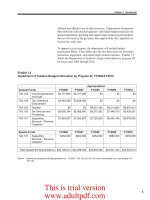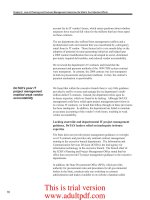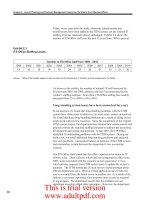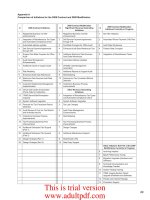Chapter 2 financial statements taxes and cash flow
Bạn đang xem bản rút gọn của tài liệu. Xem và tải ngay bản đầy đủ của tài liệu tại đây (377.02 KB, 25 trang )
Chapter 2
Financial Statements,
Taxes, and Cash Flow
McGraw-Hill/Irwin
Copyright © 2010 by The McGraw-Hill Companies, Inc. All rights reserved.
Key Concepts and Skills
•
Know the difference between book
value and market value
•
Know the difference between
accounting income and cash flow
•
Know the difference between
average and marginal tax rates
•
Know how to determine a firm’s
cash flow from its financial
statements
2-2
Chapter Outline
•
The Balance Sheet
•
The Income Statement
•
Taxes
•
Cash Flow
2-3
Balance Sheet
•
The balance sheet is a snapshot of the
firm’s assets and liabilities at a given point
in time
•
Assets are listed in order of decreasing
liquidity
–
Ease of conversion to cash
–
Without significant loss of value
•
Balance Sheet Identity
–
Assets = Liabilities + Stockholders’ Equity
2-4
The Balance Sheet - Figure
2.1
2-5
Net Working Capital and
Liquidity
•
Net Working Capital
–
= Current Assets – Current Liabilities
–
Positive when the cash that will be received over the next 12
months exceeds the cash that will be paid out
–
Usually positive in a healthy firm
•
Liquidity
–
Ability to convert to cash quickly without a significant loss in
value
–
Liquid firms are less likely to experience financial distress
–
But liquid assets typically earn a lower return
–
Trade-off to find balance between liquid and illiquid assets
2-6
US Corporation Balance Sheet
– Table 2.1
Place Table 2.1 (US Corp Balance Sheet)
here
2-7
Market Value vs. Book
Value
•
The balance sheet provides the book
value of the assets, liabilities, and equity.
•
Market value is the price at which the
assets, liabilities ,or equity can actually be
bought or sold.
•
Market value and book value are often
very different. Why?
•
Which is more important to the decision-
making process?
2-8
Example 2.2 Klingon
Corporation
KLINGON CORPORATION
Balance Sheets
Market Value versus Book Value
Book Market Book Market
Assets Liabilities and
Shareholders’ Equity
NWC $ 400 $ 600 LTD $ 500 $ 500
NFA 700 1,000 SE 600 1,100
1,100 1,600 1,100 1,600
2-9
Income Statement
•
The income statement is more like a
video of the firm’s operations for a
specified period of time.
•
You generally report revenues first and
then deduct any expenses for the period
•
Matching principle – GAAP says to show
revenue when it accrues and match the
expenses required to generate the
revenue
2-10
US Corporation Income
Statement – Table 2.2
Insert new Table 2.2 here (US Corp Income
Statement)
2-11
Work the Web Example
•
Publicly traded companies must file
regular reports with the Securities and
Exchange Commission
•
These reports are usually filed
electronically and can be searched at the
SEC public site called EDGAR
•
Click on the web surfer, pick a company,
and see what you can find!
2-12
Taxes
•
The one thing we can rely on with taxes is
that they are always changing
•
Marginal vs. average tax rates
–
Marginal tax rate – the percentage paid on
the next dollar earned
–
Average tax rate – the tax bill / taxable
income
•
Other taxes
2-13
Example: Marginal Vs.
Average Rates
•
Suppose your firm earns $4 million in
taxable income.
–
What is the firm’s tax liability?
–
What is the average tax rate?
–
What is the marginal tax rate?
•
If you are considering a project that will
increase the firm’s taxable income by $1
million, what tax rate should you use in
your analysis?
2-14
The Concept of Cash Flow
•
Cash flow is one of the most important
pieces of information that a financial
manager can derive from financial
statements
•
The statement of cash flows does not
provide us with the same information that
we are looking at here
•
We will look at how cash is generated
from utilizing assets and how it is paid to
those that finance the purchase of the
assets
2-15
Cash Flow From Assets
•
Cash Flow From Assets (CFFA) =
Cash Flow to Creditors + Cash Flow
to Stockholders
•
Cash Flow From Assets = Operating
Cash Flow – Net Capital Spending –
Changes in NWC
2-16
Example: US Corporation –
Part I
•
OCF (I/S) = EBIT + depreciation – taxes =
$547
•
NCS (B/S and I/S) = ending net fixed
assets – beginning net fixed assets +
depreciation = $130
•
Changes in NWC (B/S) = ending NWC –
beginning NWC = $330
•
CFFA = 547 – 130 – 330 = $87
2-17
Example: US Corporation –
Part II
•
CF to Creditors (B/S and I/S) = interest
paid – net new borrowing = $24
•
CF to Stockholders (B/S and I/S) =
dividends paid – net new equity raised
= $63
•
CFFA = 24 + 63 = $87
2-18
Cash Flow Summary -
Table 2.5
2-19
Example: Balance Sheet and
Income Statement Information
•
Current Accounts
–
2009: CA = 3625; CL = 1787
–
2008: CA = 3596; CL = 2140
•
Fixed Assets and Depreciation
–
2009: NFA = 2194; 2008: NFA = 2261
–
Depreciation Expense = 500
•
Long-term Debt and Equity
–
2009: LTD = 538; Common stock & APIC = 462
–
2008: LTD = 581; Common stock & APIC = 372
•
Income Statement
–
EBIT = 1014; Taxes = 368
–
Interest Expense = 93; Dividends = 285
2-20
Example: Cash Flows
•
OCF = 1,014 + 500 – 368 = 1,146
•
NCS = 2,194 – 2,261 + 500 = 433
•
Changes in NWC = (3,625 – 1,787) – (3,596 –
2,140) = 382
•
CFFA = 1,146 – 433 – 382 = 331
•
CF to Creditors = 93 – (538 – 581) = 136
•
CF to Stockholders = 285 – (462 – 372) = 195
•
CFFA = 136 + 195 = 331
•
The CF identity holds.
2-21
Quick Quiz
•
What is the difference between book value
and market value? Which should we use for
decision-making purposes?
•
What is the difference between accounting
income and cash flow? Which do we need to
use when making decisions?
•
What is the difference between average and
marginal tax rates? Which should we use
when making financial decisions?
•
How do we determine a firm’s cash flows?
What are the equations, and where do we
find the information?
2-22
Ethics Issues
•
Why is manipulation of financial
statements not only unethical and illegal,
but also bad for stockholders?
2-23
Comprehensive Problem
•
Current Accounts
–
2009: CA = 4,400; CL = 1,500
–
2008: CA = 3,500; CL = 1,200
•
Fixed Assets and Depreciation
–
2009: NFA = 3,400; 2008: NFA = 3,100
–
Depreciation Expense = 400
•
Long-term Debt and Equity (R.E. not given)
–
2009: LTD = 4,000; Common stock & APIC = 400
–
2008: LTD = 3,950; Common stock & APIC = 400
•
Income Statement
–
EBIT = 2,000; Taxes = 300
–
Interest Expense = 350; Dividends = 500
•
Compute the CFFA
2-24
End of Chapter
2-25









